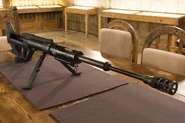The IWS 2000 (short for Infantry Weapon System 2000) is a prototype semi-automatic anti-matériel rifle, produced by Steyr Mannlicher.
History
The project started in the mid-1980s, during which there was an interest in the development of heavy sniping rifles that are intended to destroy enemy equipment. Unfortunately, the word "sniping" suggests anti-personnel shooting, which would give many people the wrong idea about the function of these large-caliber weapons. Steyr Mannilcher avoided this by classifying the weapon as an "anti-matériel" rifle.
At the time, they envisioned a two-man, single-shot rifle capable of accurate fire up to 1000m, with the intended targets being lightly armored vehicles, armored personnel carriers, electronics equipment, and helicopters. Early trials with experimental ammunition based on 12.7mm caliber cartridges demonstrated that an APFSDS (armor-piercing fin-stabilized discarding-sabot) approach would be more beneficial.
This resulted in the AMR 5075, of which Steyr manufactured a small number for experimental purposes. AMR is an abbreviation for "Anti-Matériel Rifle". The weapon used a 14.5mm APFSDS round, which evolved from an earlier 15mm round. The weapon was first publicly showcased in 1990. Unfortunately, at the time, military spending was on the decrease, and though a great deal of interest was expressed, it was not adopted.
This lead to Steyr refining the weapon further, with the program being renamed IWS 2000 and the caliber of the APFSDS round being changed.
Development of the weapon was considered to be complete. However, it appeared that the IWS 2000 was never formally adopted.
There is one known manufacturing sample of the weapon that is still in existence, kept in the Steyr Mannlicher arms factory in Kleinraming, Austria. However, the rifle appears to be missing both its bolt and an optic sight.
Design Details
The IWS 2000 is actually a smoothbore weapon, like many modern tank guns, and not a true rifle but this can help accelerate projectiles and increase ballistic effectiveness.
This rifle is based on a 9.75 inch long-recoil mechanism. This mechanism, which is usually found in shotguns, helps manage the heavy recoil forces of the 15.2×169mm APFSDS round. This is due to its damping effect that allows for force distribution over a longer period of time. Another unusual feature of the weapon is the movement of the barrel. After firing, the barrel recoils into a shock-absorbing, hydro-pneumatic sleeve, much like those found on an LG 1 Mark II 105mm Howitzer. The mechanism employs the long recoil principle of operation, the barrel and bolt recoiling for about 200mm, after which the bolt is unlocked and held while the barrel is returned to battery. The bolt is then released, collects a cartridge from the magazine and chambers it, locking into the barrel by a rotary motion.
The IWS 2000 also uses a multi-baffle muzzle brake to distribute muzzle energy and further reduce recoil, similar to the ones used on D-30 2A18M 122mm Towed Howitzers. The entire rifle body is made up of a combination of high-tension plastics and super-light polymers to increase manageability and cut down on weight. The smoothbore barrel is easily detached and packed away for increased mobility. A five-round detachable box magazine is inserted on the right side of the weapon at a 45-degree downward angle.
For a sighting system, the IWS is fitted with a 10x optic scope as standard. It also has a monopod at the rear that is dial-adjustable.
Ammunition
The IWS 2000 fires a proprietary 15.2×169mm APFSDS round. Specifically designed for the IWS 2000, it contains a fin-stabilized, dart-shaped penetrator of either tungsten carbide or depleted uranium, capable of piercing 40mm of Rolled Homogeneous Armor (RHA) at a range of 1000 meters, and causing secondary fragmentation. The cartridge is comprised of a plastic case, a steel head, and a plastic sabot shell around the penetrator.
Test results had shown that the penetrator has a much flatter trajectory than the .50 BMG round.
Gallery
References
- Steyr AMR 5075
- Steyr AMR 5075
- Steyr IWS 2000
- Modern Firearms
- Doppeladler forum topic: Schwere Scharfschützengruppe? (German)
- Imgur gallery: Steyr IWS 2000 Anti-Matériel Rifle (AMR) by 3rdweal
- The Firearm Blog: Steyr Mannlicher Factory Tour

